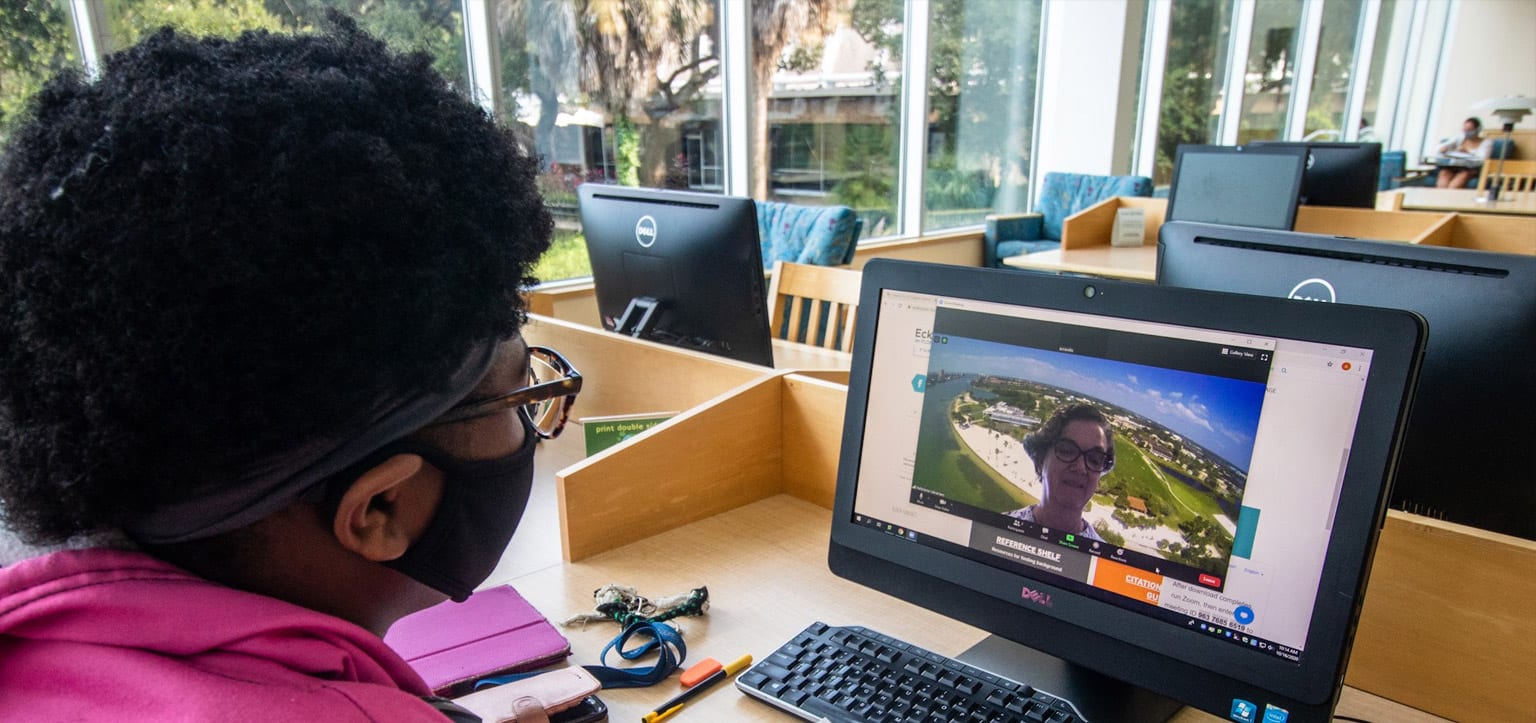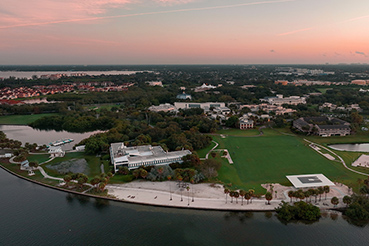
An Eckerd student visits Director of Library Services Lisa Johnston in the Zoom reference room.
The first things to go were the couches.
“We had a big summer of moving furniture,” said Associate Professor and Director of Library Services Lisa Johnston at the Peter Armacost Library at Eckerd College. “We removed 50% of our seating. Everyone likes to smush up on sofas, so we put those away. We currently have 191 seats in storage.”
Libraries are central to college operations. Faculty rely on the institutional library to provide texts and references for teaching, and students rely on the repositories for study, research and leisure. During a global pandemic that discourages gathering in communal spaces, libraries across the nation—including Eckerd’s—had to get creative to figure out how to serve their communities. Johnston’s clever crew devised a hybrid in-person and digital strategy aimed at curbing capacity while also meeting everyone’s needs.
Even before the pandemic, the College began updating its digital-catalog search engine to OneSearch, a faster, more intuitive tool, it searches through all the library’s assets, including films and journal articles, to bring comprehensive results. “It went live in July and we are really pleased,” Johnston said. “It might be our biggest COVID innovation.”
Academic and leisure readers who used to peruse the stacks searching for the next text can now scan a robust online catalog of books available for loan to e-readers like the Amazon Kindle through OverDrive, which also is popular with municipal libraries across the country. Students, faculty and staff use their eckerd.edu email addresses to gain access to the entire digital collection, which continues to grow, Johnston added. “We will curate collections there based on what is of interest to the community,” she said. “Over the summer, Nancy Schuler, assistant professor and collection development and electronic services librarian, put together a Black Lives Matter–themed collection with important texts that spoke to what was happening in the country.”
Reference librarians have found a way to keep their open-door policy while also keeping their distance. Tritons can ask a reference librarian for help researching materials through an online chat or a Zoom reference room, where someone on duty can speak with patrons screen-to-screen.
“Our team can really think on their feet,” Johnston laughed. “The Zoom reference room is not the same as being able to sit six inches from someone and look through texts, but the share-screen option allows for a much closer approximation than a phone call.”
Those who absolutely must use the physical library will find the experience cosmetically different, but exactly the same in spirit.
Community members can schedule contactless material pickup, where they can grab stacks of books and movies with their names on it without ever speaking to someone face to face. Also, all returned materials, with one exception, are quarantined in a special room for a minimum of six days before being disinfected and reshelved. Books on reserve for faculty’s courses are immediately disinfected and returned to circulation.
The spaces have been rethought as well. Most seating is single chair, and first-floor study tables have two chairs at opposite ends or on opposite sides. Study rooms reopened August 31 during Block 1, and every door is labeled with a cheery blue sign indicating the number of people allowed in at once. Furniture is spaced to prevent students from failing to maintain social distance.
“This is the first time I’m using the library like this,” said Mark Sippel, a first-year student from Denver, Colorado, who opted to use the two-person study room on the second floor to study for an Intro to Psychology exam with a classmate, sophomore Joy Ebert from Foster, Kentucky.
“We chose this because it’s quiet and away from all the other distractions that other places have,” Joy explained.












